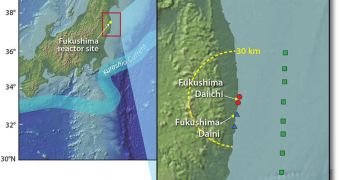Experts handling the Fukushima Daiichi nuclear power plant accident say that radioactive water made its way into the Pacific Ocean many times since the March 11 earthquake that crippled the installation. A new study now looks at how radioactivity damaged the ocean during the first four months.
It therefore covers a period spanning from March to June 2011. This is when the situation was most critical, as the four damaged reactors at the power plant were uncooled. At that time, rescue efforts had not yet been successful, despite numerous attempts.
One of the issues that experts highlighted at the time was that of improper monitoring of oceanic contamination offshore from Fukushima. Surveys were carried out by science teams, not authorities, and it takes months for conclusions from such investigations to be made public.
This particular research was carried out by scientists in Japan and the United States, who kept a close eye on how the first radioactive spills from the nuclear power plant affected the Pacific Ocean.
Woods Hole Oceanographic Institution (WHOI) chemist Ken Buesseler conducted the researcher with Meteorological Research Institute expert Michio Aoyama and Japan Agency for Marine-Earth Science and Technology investigator Masao Fukasawa.
The most important conclusion was that the radioactive material concentration in the water spiked about a month after the onset of the crisis, and remained at high levels through at least July.
“Understanding and management of the long-term geochemical fate and ecological consequences of radiochemical contamination of the sea is dependent on our knowledge of the initial conditions,” National Science Foundation official Don Rice explains.
“Acquiring that knowledge depends on our ability to deploy experts to the scene with minimal delay,” adds the expert, who is the director of NSF Chemical Oceanography Program at the Division of Ocean Sciences. The DOS funded part of this investigation.
“The release of radioactivity from Fukushima – both as atmospheric fallout and direct discharges to the ocean – represents the largest accidental release of radiation to the ocean in history,” an NSF press release informs.
“Concentrations of cesium-137, a radioactive isotope with a 30-year half-life, at the plants' discharge points to the ocean peaked at more than 50 million times normal/previous levels,” the statement adds.
“Concentrations 18 miles offshore were higher than those measured in the ocean after the Chernobyl accident 25 years ago,” the document concludes. Researchers will continue to monitor the area for signs of contamination over the next few months.

 14 DAY TRIAL //
14 DAY TRIAL //